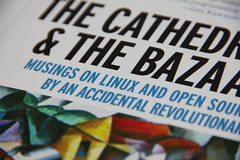I own a piece of paper which came to me through the network of mindfulness classes, meet-ups and meditation sittings that exist in the Republic of California.
For today, I am posting it verbatim. It is precious enough to me that I want it preserved forever on the internet. If I have to type it up and post it for that to happen, so be it. I just want it to be out there and I predict others will also see the truth in it.
There is also a reason for my timing. Markus Gärtner, author of the newly published ATDD by Example (and tester of Amazon’s I18n encoding) has recently posted on some of the fallacies involved in contextual testing. What he writes about seems awfully close to distorted thinking which is not surprising given the fact that we are all human.
Being human means that if you have a bad lunch or some cloud system goes down which keeps you from your testing, the physical reaction of frustration leaves you very open to distorted thinking. In the case of testing, some of this distorted thinking seems useful for uncovering test ideas, and yet we also need to recognize when it’s time to stop catastrophizing and time to start collaborating with our teammates. If we can recognize the distorted thinking we use for test heuristics, perhaps we can also recognize when it is time to leave the distorted thinking behind. Polarization is for formal methods…not friends.
Without further ado:
Filtering: You take the negative details and magnify them while filtering out all positive aspects of a situation.
Polarized Thinking: Things are black or white, good or bad. You have to be perfect or you’re a failure. There is no middle ground.
Overgeneralization: You come to a general conclusion based on a single incident or piece of evidence. If something bad happens once, you expect it to happen over and over again.
Mind Reading: Without their saying so, you know what people are feeling and why they act the way they do. In particular, you are able to divine how people are feeling toward you.
Catastrophizing: You expect disaster. You notice or hear a problem and start, “what if’s: what if tragedy strikes? What if it happens to you?”
Personalization: Thinking that everything people do or say is some kind of reaction to you. You also compare yourself to others, trying to determine who’s smarter, better looking, etc.
Control Fallacies: If you feel externally controlled, you see yourself as helpless, a victim of fate. The fallacy of internal control has you responsible for the pain and happiness of everyone around you.
Fallacy of fairness: You feel resentful because you think you know what’s fair, but other people won’t agree with you.
Blaming: You hold other people responsible for your pain, or take the other tack and blame yourself for every problem or reversal.
Should: You have a list of ironclad rules about how you and other people should act. People who break the rules anger you and you feel guilty if you violate the rules.
Emotional reasoning: You believe what you feel must be true automatically, If you feel stupid and boring then you must be stupid and boring.
Fallacy of Change: You expect that other people will change to suit you if you just pressure or cajole them enough. You need to change people because your hopes for happiness seem to depend entirely upon them.
Global labeling: You generalize one or two qualities into a negative global judgement.
Being right: You are continually on trial to prove that your opinions and actions are correct. Being wrong is unthinkable and you will go to any length to demonstrate your rightness.
Heaven’s reward Fallacy: You expect all your sacrifice and self-denial to pay off, as if there were someone keeping score. You feel bitter when the reward doesn’t come.
There are a few of these that I recognize a little to comfortably and I’m guessing that this didn’t quite make it into the Myers-Briggs. Who are you?














